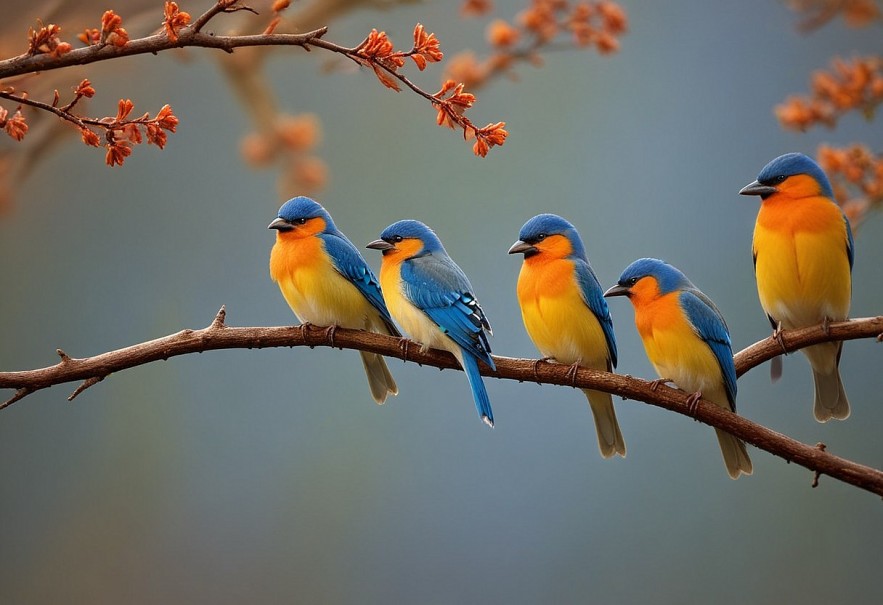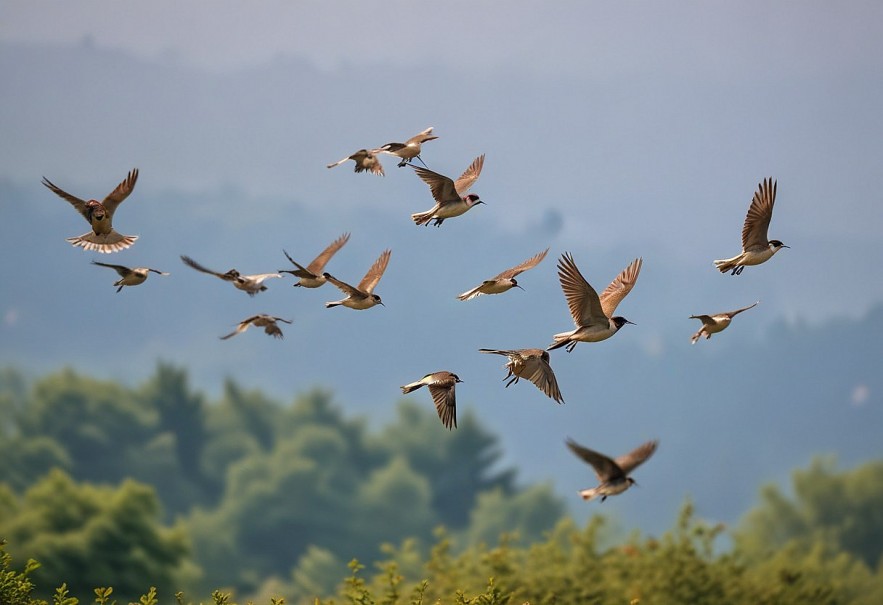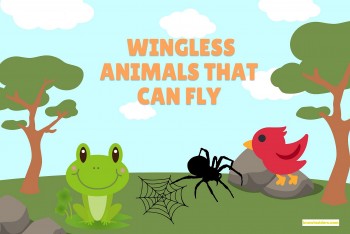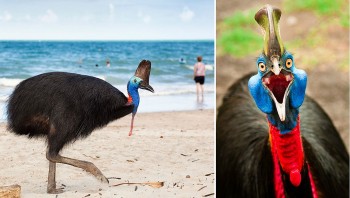Facts About Bird’s Sleep - Sleeping While Flying and One Eye Open
| Table of Contents |
Do Birds Get Any Sleep?
Indeed, avian sleep occurs. The majority of songbirds locate a lonely branch or a hollow in a tree, fluff up the down feathers behind the outer feathers, bend their head back, bury their beak into the feathers on their backs, and shut their eyes.
Sometimes, waterbirds snooze in the water. There are those who sleep in caverns or on tree branches. Certain ducks can be seen to be actually half sleeping, with one eye closed and one half of their brains dozing off while the other eye and brain are active in scouting for potential predators.
 |
| Interesting Facts About Bird’s Sleep |
Benefits of Sleep for BirdsThe benefits of sleep are universal across the animal kingdom. Sleep conserves energy by slowing the metabolism, allowing animals to avoid high-energy behaviors. Sleep is an important aspect of vertebrate brain development, as it strengthens brain cell connections and memory. Lack of sleep or interrupted sleep cycles might impair young birds' learning and memory development. Artificial light can also interrupt birds' sleep, causing them to have less deep, REM sleep, particularly in urban locations where artificial light is intense. Some disoriented birds may fly around artificial light in loops, or worse, smash into illuminated buildings. Sleeping can even help some birds remember their songs. In 2008, scientists observed that juvenile zebra finches practice songs learned from adult finches while sleeping. The next day, the young birds' songs improved noticeably. They may even be able to learn new tunes as they sleep. |
Where Do Birds Sleep?
Depending on their species and the season, birds sleep in a variety of locations.
Many cavity-nesting species spend the winter together in ancient woodpecker cavities, birdhouses, or roosting boxes. These species include Chickadees, Nuthatches, and Titmice. Nonetheless, the female typically sleeps on the nest throughout nesting season, with her mate either right next to her or fairly close by.
During the nesting season, most open-nesters sleep in a similar manner, although others do not, such the male Red-winged blackbird, which sleeps by himself. In winter, open-nesters, like mourning doves and cardinals, congregate at night to sleep in a shared "roost," which is typically found in thickets, shrubs, or dense evergreens.
READ MORE: Facts About Whooping Cranes - Tallest and Rarest Birds In North America
Where do birds sleep at night?Expert birdwatchers Kenn and Kimberly Kaufman say that wild birds are adept at locating a place to stay. Birds that nest inside tree holes, like woodpeckers and bluebirds, frequently spend the night in these cavities throughout the year. Certain types of birds locate safe havens within the thick foliage of vines, bushes, and trees. They might take up residence at the downwind side of the trunk. Birds that inhabit open fields or shorelines may choose to stay still and face the wind. Birds typically seek out areas where they spend the night during stormy weather, or they will go above and beyond to find a location that is even more sheltered. As dusk falls, nocturnal avian species such as owls and whip-poor-wills are just getting started. However, where do day-tripping birds spend their nights? The majority of them locate a quiet area to sleep, although birds' sleep is not the same as ours. |
Can Birds Sleep While Flying?
 |
Some birds can fly and only wake up partially. Scientists discovered something amazing in 2016: frigatebirds, a particular kind of seabird, can fall asleep while in the air. During migration, the birds can fall asleep while in flight, using one or both half of their brains to stay asleep without having to stop and rest. A frigatebird that has one eye open when resting is probably not keeping an eye out for predators, but rather to avoid colliding with other birds or objects.
When migrating, frigatebirds sleep for less than an hour a day, despite this incredible performance. How or why they avoid going without sleep is still a mystery. Scientists have discovered more recently that swifts sleep in the air.
The common poorwill is the only species of bird that hibernates. A controlled hypothermic condition known as hibernation can persist for several weeks or even months. In order to conserve more energy than they can during typical sleep, animals that hibernate lower their body temperature, heart rate, and metabolism. When the common poorwill hibernates in meadows and shrublands, its mottled feathers help to blend it into the surroundings.
A comparable state known as torpor, or transient hibernation, is experienced by hummingbirds. Although torpor typically lasts for a few hours, hummingbirds have the ability to go into a deep torpor that lasts all night, during which they may experience a 20°F drop in body temperature. To put things in perspective, a 3°F drop in body temperature would cause hypothermia and necessitate medical intervention. The mystery of how a hummingbird can emerge from deep torpor and rewarm itself every morning remains a puzzle to scientists.
How Do Birds Stay Warm While Sleeping?
It's difficult for sleeping birds to stay warm at night. Because feathers offer robust insulation, birds curl up inside themselves. Ducks, geese, and swans are frequently observed dozing off with their bills tucked under their feathers. Numerous animals will also raise a leg into their comfortable small spaces.
In periods when they are not actively incubating eggs or young, birds seldom use their nests as nighttime roosts. Few cavity nesters, such as chickadees, wrens, and nuthatches, use nest boxes all year round. It has been observed that acorn woodpeckers, bluebirds, pygmy nuthatches, and tree swallows all share the same cavities when they roost in small groups.
Fun facts about bird's sleep
 |
Sleeping with one eye open
Since it exposes you to predators and other hazards, falling asleep can be a risky experience. Many prey species must sleep, so to speak, with one eye open and remain alert all the while, but did you know that certain birds do just that? Unihemispheric slow-wave sleep, or USWS, is a kind of sleep in which only one side of the brain is asleep. This enables them to relax and remain vigilant at the same time; ducks and other waterbirds, Eurasian blackbirds, and peregrine falcons, to mention a few, accomplish this. Furthermore, the amount that a bird's eye is open determines how awake or asleep it is!
Dreaming while sleeping
Although it's unknown if birds dream while they sleep, they can occasionally move their eyes quickly. Zebra finch research has demonstrated that song-related brain neurons can fire as they sleep, however this could just be a means of enhancing song learning rather than evidence of dreaming.
Singing at night
It feels strange to hear the American robin's cheery cheerio singing after dark. However, the same reasons that robins, mockingbirds, and many other daytime-loving birds sing at night are the same as those that drive them to mark their territories and draw in mates.
Birdsong is not muffled after dark since human-caused noise pollution decreases. For example, studies on European robins in cities revealed that evening was the best period for singing.
Are birds able to sleep in their nests?"For most birds, the nest is just a cradle for their eggs and chicks, used only until the young birds can fly," Kenn and Kimberly state. Eagles and other large birds may utilize the same nest every year. Though it's more common for songbirds to construct a new nest for each brood, some are capable of renovating and using an existing nest twice. Woodpeckers and bluebirds, among other nesting birds, can spend the entire year in the cavity. Nonetheless, most bird species don't require nests; instead, they can roost in safe places among trees, shrubs, the ground, or open water. |
 Top 10 Wingless Animals That Can Fly Like Birds Top 10 Wingless Animals That Can Fly Like Birds Many animals on Earth do not have wings but can fly like birds. What do they use to be able to fly? |
 Top 13 Lovely Birds That Can’t Fly and Full List of The Flightless Birds Top 13 Lovely Birds That Can’t Fly and Full List of The Flightless Birds The first thing we think about birds is flying but in fact not all of birds can fly. Check out Top 13 and full list ... |
 Top 10 Most Intelligent Talking Birds in The World Top 10 Most Intelligent Talking Birds in The World Some parrot species such as the African Gray Parrot, Yellow-naped Amazon are known for their ability to understand human language better. Here is a list ... |
























